Catullus at work
Posted by Richard on UTC 2019-07-16 14:02
That we are able to read Catullus' work at all these days is a cause for wonder, for the existence of his work in modern times represents a quite astonishing tale of survival. Let's start in the age of Catullus and follow his poems on their journey down the ages to us in the modern bookshop. Catullus lived in a place and at a time that is very strange to us, its culture barely comprehensible to us moderns.
Before we can set off, however, we need to answer a seemingly simple question: how would Catullus have written his poetry? Or, put another way, in what form did Catullus' poetry exist in his lifetime?
Erasing the modern world
We have to reset our 21st century brains to answer these questions.
For the last century or two, writing has been simple and cheap. Since the mid-19th century paper has become a cheap, near worthless commodity; printing too became a relatively inexpensive process; books, once objects to treasure, became throwaways, many become obsolete shortly after publication. The typewriter and the carbon copy changed our lives in ways we no longer appreciate.
Before the copier, and particularly before printing, copies could only be made by hand and with effort – every text had its value measured by whether it was worth copying or not. Before Johannes Gutenberg invented printing with moveable type in 1439, this perceived value largely determined the propagation and survival of a text.
The various technological iterations of the copier in the 20th century brought another profound revolution: older readers will be able (just) to cast their minds back to a time when there was no easy and inexpensive way to reproduce a document or a book – even for them the imaginative jump into the past from the overwhelming reality of the present day will take some effort.
The digital revolution of the last fifty years has gradually replaced paper with free pixels; text, once fixed for ever when the ink flowed on the paper, is now infinitely editable, changing the entire procedure of writing and revising.
Documents can be printed directly in almost every home; existing documents can be scanned as images and the text they contain recovered with optical character recognition. There are now as good as no limits on the utilisation of written text. Idiots and sages are scribbling day in, day out and publishing without charge to the rest of the world, ready to be downloaded or copied, pasted, shared, forwarded and stored.
Obedient to the iron law of supply, demand and price, text is now effectively worthless.
Memory
In the centuries before this technological innovation, memory was much more important in everyday life than it is now.
Nowadays we don't really need to remember text passages at all: a few taps on a smartphone from anywhere in the world – a street, a hotel, a cruise liner, an aircraft – will retrieve them. In previous times, however, readers would routinely acquire texts by heart; we could tell tales of the routine memorising performed by our ancestors that now strike us as prodigious feats of memory.
The heads of our educated ancestors were full of remembered texts. Our readers only have to think back to Klopstock and the quantity of verse his young companions 'sang' during their journey on the Lake of Zurich in 1750 – the boat certainly wasn't full of expensively bound volumes from which they quoted.
The life of the mind in general was much more oral then than it is now. Texts were often read aloud in groups and remembered and quoted as oral phenomena.
The Schubert fans among our readers may recall the 'reading society' based around Franz von Schober that held readings in Vienna during the 1820s, mostly performed in Schober's fine actor's baritone. Compare that phenomenon with its modern counterpart, the reading or book club, in which everyone has a copy of a particular book, reads it in private and then assembles at intervals to talk about it (or themselves, whichever is more interesting).
Because access to written texts was frequently troublesome and often impossible, quotation was habitually done from memory, except for particular scholarly situations. The fetish for accurate quotation down to each punctuation mark can be maintained in our digital age, but more than a century or so ago this was a difficult requirement for normal persons to meet.
Roman text processing
Having now cleared our minds of all these modern conveniences for dealing with written texts, we can now at last get ourselves back on the road to the world of Catullus.
Just as it was with Klopstock and his young people, Catullus' first method of text storage would have been his memory. We don't need to labour the importance of this faculty for the practising artist. It is a commonplace that Greek (and Roman) mythology has the nine (or three) muses as the daughters of the union of Zeus, the king of the gods, and Mnemosyne, the goddess of memory.
Waxing lyrical
For temporary storage, Catullus had the tabula cerata/cerea, a light wooden board covered in (usually black) wax, typically fitted with a hinged wooden cover for transport. He could scratch notes and jottings into the wax with the sharp point of a stylus and smooth away sections with the small spatula at its other end. For a fresh start, the wax could be melted to provide a tabula rasa, a 'scraped tablet'.
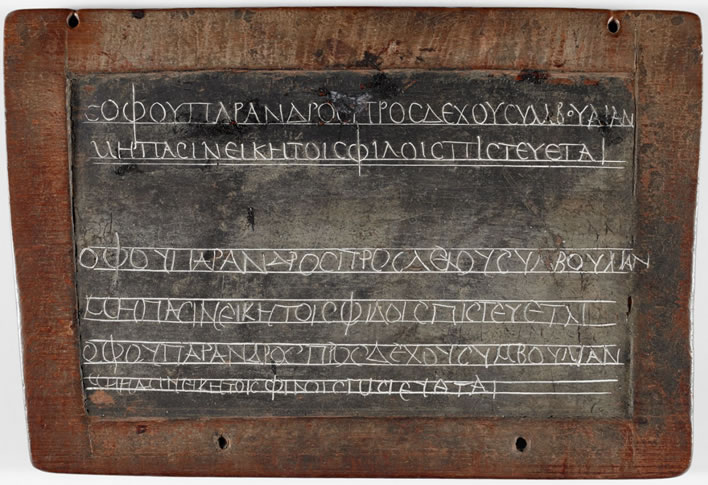
Wax tablet from the 2nd century AD, language Ancient Greek, size 178 x 260 mm. BL commentary: 'A teacher wrote two iambic maxims (gnomai) on two ruled lines (Menander, Sententiae 476). A student copied them twice between ruled lines, always omitting the sigma that starts the first sententia. The last two lines are written in a very narrow space.' Image: British Library.

Wax tablet from the 2nd century AD, language Ancient Greek, size 178 x 260 mm. BL commentary: 'A proficient hand, which could be the teacher’s, writes multiplication tables in the left portion of the tablet. Apparently, the same student of the previous tablet writes five words divided into syllables after dividing the right part of the tablet into rectangular spaces by means of horizontal and vertical lines.' Image: British Library.
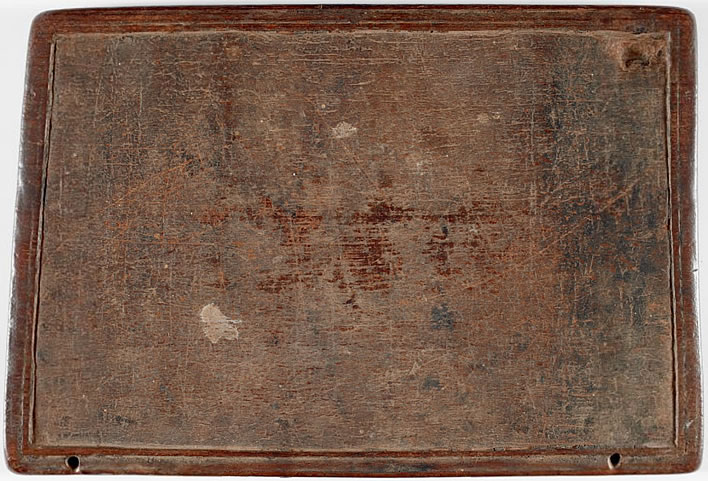
Wooden base for a wax tablet from the 2nd century AD, size 178 x 260 mm. Hot wax would be poured into the depression. Image: British Library.
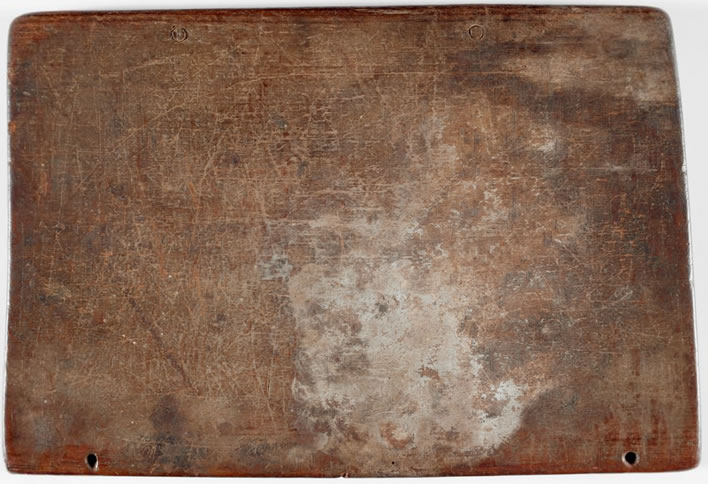
Cover or reverse side of a tablet, size 178 x 260 mm. Image: British Library.
The wax tablet could be used as a notebook, a scratchpad(!), or to send or circulate short or fragmentary texts to friends, for example. His tablets appear to have been one of Catullus' dearest possessions, he knows them as his pugillaria and his codicilli and they feature in his charming poem [c 42]:
Catullus has a problem. He summons his poems, his 'hendecasyllables' to his aid:
O come, all ye hendecasyllables, as many as you are, from every part, all of you, as many soever as you be!
Adeste, hendecasyllabi, quot estis / omnes undique, quotquot estis omnes.
The full stop gives time for his gang of poems to assemble from far and wide. Once they have arrived he explains their errand to them:
A filthy whore thinks that I am a joke, and says she won't return to me your writing tablets, if you can stand it. Let's pursue her, and claim them back.
iocum me putat esse moecha turpis / et negat mihi vestra reddituram / pugillaria, si pati potestis. / persequamur eam, et reflagitemus.
Their task is to pursue and mob a woman who has walked off with their pugillaria, writing tablets (NB: 'their' tablets, which belong explicitly to the poems, not to their author). How will we know her? the poems ask:
'Who is she?' you ask. That one, whom you see strutting disgracefully, grinning with annoyance like a mime with a face like a Gallic puppy. Surround her, and claim them back.
quae sit quaeritis? illa quam videtis / turpe incedere, mimice ac moleste / ridentem catuli ore Gallicani. / circumsistite eam, et reflagitate:
The poems surround the woman and mob and harass her, trying to intimidate her into returning 'their' tablets. This mobbing procedure, flagitatio, aimed at righting a perceived wrong where no other legal remedy was available involves surrounding the outnumbered victim and hurling abuse and insults until some degree of shame brings about the desired result. The technique was as known to the Romans as it is to the modern world, at least wherever Mediterranean temperaments are involved:
'Filthy whore, give back the writing tablets; give back, filthy whore, the writing tablets.' You don't give two cents? You slime, you whorehouse, or if you could be anything even more loathsome! But you mustn't think that this is enough. For if nothing else we can extort a blush on your brazened bitch's face. We'll yell again in heightened voice, 'Filthy whore, give back the writing tablets; give back, filthy whore, the writing tablets.'
'moecha putida, redde codicillos, / redde, putida moecha, codicillos.' / non assis facis? o lutum, lupanar, / aut si perditius potes quid esse. / sed non est tamen hoc satis putandum. / quod si non aliud potest, ruborem / ferreo canis exprimamus ore. / conclamate iterum altiore voce / 'moecha putida, redde codicillos, / redde, putida moecha, codicillos.'
But the mobbing fails and so the only recourse is politeness:
But we do no good, she isn't moved. We must change our approach and our tune, if you can make further progress — 'Chaste and honest, give back our writing tablets.'
sed nil proficimus, nihil movetur. / mutanda est ratio modusque nobis, / si quid proficere amplius potestis, / 'pudica et proba, redde codicillos.'
[c 42.1-24]
I am indebted to Eduard Fraenkel for his fine interpretation of this poem in 'Two Poems of Catullus' in the Journal of Roman Studies 51, 1961, p. 46-53. JSTOR (paywall).
We have here not only learned something about the wax tablet, but have also enjoyed a taste of Catullus the poet – his urbane, witty and entertaining style that made him famous among his contemporaries.
Catullus also tells us of the collaborative use of wax tablets in a composition game with his fellow poet Licinius Calvus (82 BC-47 BC?), whose poetic works are lost:
Yesterday, Licinius, in leisure much we played upon my tablets, as became us, men of fancy. Each jotting verses in turn played first in this meter then in that, exchanging mutual epigrams amid jokes and wine.
Hesterno, Licini, die otiosi / multum lusimus in meis tabellis, / ut convenerat esse delicatos. / scribens versiculos uterque nostrum / ludebat numero modo hoc modo illoc, / reddens mutua per iocum atque vinum.
Several words for the same thing: cera (wax), codicilli (small board ~codex), pugillaribus (handy!), now tabella (small board).
[c 50.1-21]

A remarkable artefact from the (late) 1st century AD (82 or 95 A.D.[?]), showing human ingenuity in finding things to write on. The Latin text is the honorable discharge of a legionary soldier. University of Michigan commentary: 'This fragment of a wooden tablet was prepared for use as a wax tablet, but later the wax was very thorouhly scraped off except for slight remnants in the corners. The surface of the wood suffered somewhat under the scraping. The tablet was then used for this document, written with ink on the wood. (...) The lines of writing run at right angles to the direction expected on the interior of a diptych but agree with a form of a triptych; signatures of witnesses would have been written on the back of the second of the three tablets.' Image: University of Michigan.
The Egyptian reed
The next medium available to him were sheets of papyrus. At various points in his poems he mentions the papyrus on which he writes his poetry – just as was the wax tablet, the sheet of papyrus was an important tool of his poetic trade.
We moderns need to take a close look at the medium of papyrus in order to understand it as Catullus would have done.
Papyrus is made from the fibrous pith of reeds. The reed was cut open and its fibrous interior cut out as thin strips. The strips were laid side by side with a tiny overlap. A papyrus sheet normally consisted of two layers of strips with the grain of one layer at 90 degrees to the other for mechanical stability. The 'horizontal' strips formed the inside of a roll of papyrus, the vertical strips were on the outer, more vulnerable side. It was difficult to write across the grain of the vertical fibres, most people preferred to write along the grain, meaning the papyrus was only rarely written on both sides.
Once laid down, the sheet of strips was pressed between cloths and allowed to dry. Papyrus was produced as sheets and then usually made into rolls for sale and distribution, normally containing about 20 sheets. Users could cut blank sheets of appropriate sizes from these rolls as required – for letters, for example, or even for the odd poem.
Sheets, once written, could be glued back together into rolls or even appended or inserted into existing rolls. In this way complete scroll 'books' could be created. Text was written in columns across the direction of scrolling. The average height of the roll was about 20 cm (~nine inches) which provided space for somewhere between 25 and 45 lines.

Detail of a papyrus fragment written in Latin dating from 41-54 AD, containing a speech by the Emperor Claudius to the Senat. The reverse side contains an invoice in Greek for work on a waterway dyke, a good example of the reuse of papyrus. Size of detail: c. 220 x 250 mm. Image: Berliner Papyrusdatenbank. [Click to open the full image in a new browser tab]
Catullus was not strapped for cash, but good papyrus was not cheap. In his Naturalis Historia, 'Natural History', Pliny the Elder, writing roughly a century after the time of Catullus, identified nine grades of quality in papyrus, ranging from the very highest qualities used for texts of corresponding importance to the lowest, used for wrapping-paper and for making ropes.
The production of papyrus was also in monopolistic hands during most of this period, which meant that its supply could be throttled and its price artificially boosted. For this reason it was also normal to take a used papyrus, scrub the previous text away with pumice stone and re-use the surface. This was the 'palimpsest'. If the writer couldn't be bothered preparing the papyrus (a task Catullus would have given to a slave) he could simply write the new text between the lines of the existing text to create an 'interlineal palimpsest'.
This technique was often used for letters: either the recipient would scrub the papyrus clean and use it for the reply or write the reply between the lines of the original letter. When a reply was expected, desired or hoped for, thoughtful correspondents writing to the less well-off might enclose a blank piece of papyrus for that purpose.

A papyrus from the 2nd century AD ('February 18') written in Latin in a formal cursive hand. Size 99 x 85 mm. University of Michigan commentary: 'Acknowledgment of a debt owed (by a soldier?) to soldiers of the Alexandrian fleet (classis Augusta).' Image: University of Michigan.
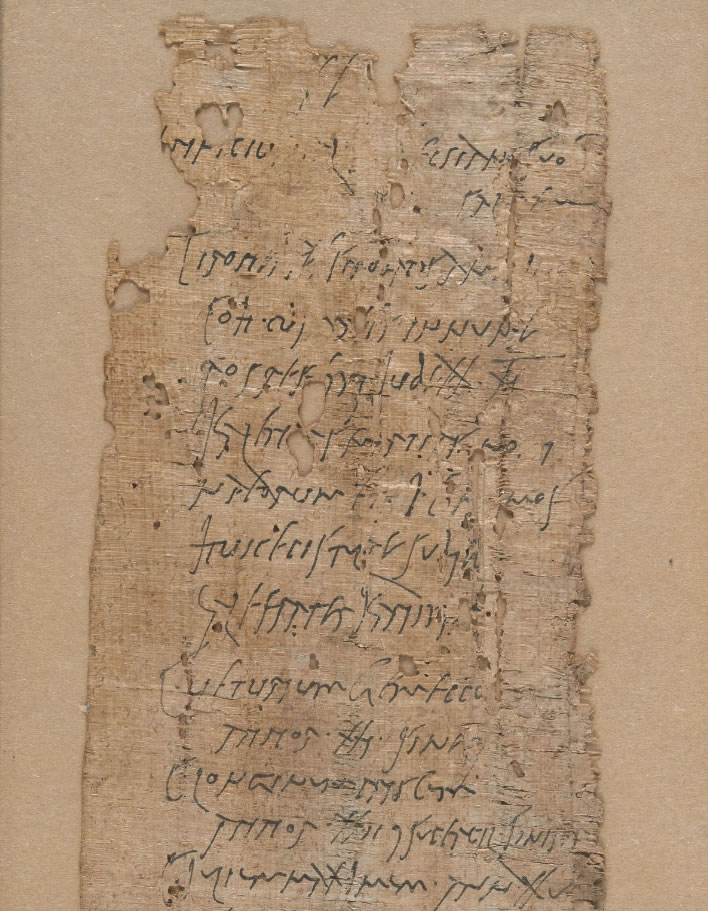
A detail from a copy of a letter about six army recruits written in Latin in a cursive hand on papyrus about 103 AD. Size 87 x 370 mm. BL commentary: 'This is the copy of the letter issued by Gaius Minucius Italus, prefect of Egypt, to Celsianus, commander of the cohors III Ituraerorum, about the enrollment of six recruits in the cohort. For each soldier tria nomina, age, and distinctive physical details are recorded. The senior clerk (cornicularius) of the unit, Avidius Arrianus, certified the copy (see lines 24-31).' Image: British Library. [Click on the image to show the full letter in a new browser tab]
The black ink used on papyrus consisted of a suspension of black matter such as charred organic material or soot in water with some form of glue. In Roman times the pen would usually be a narrow, hollow reed. The ink did not penetrate into the papyrus and stain it as a modern ink would, instead the black particles, bonded by the glue, remained on the surface. This lack of penetration is the reason that papyrus could be cleaned simply by being abraded with a pumice stone.
In one of his poems Catullus reworks a common literary insult of his time: that an opponent's literary efforts would so devalue the papyrus they were written on that it would end up as wrapping paper for mackerel. British readers of a certain age may remember the old jibe about today's newspapers being tomorrow's fish and chip wrappings.
But Volusius' Annals will die at Padua itself, and will often furnish loose wrappings for mackerel.
at Volusi annales Paduam morientur ad ipsam / et laxas scombris saepe dabunt tunicas.
[c 95.7-8]
In another poem Catullus, in a rhetorical apostrophe, even addresses directly the papyrus used for a letter:
Paper, I would like you say to that sweet poet, my comrade, Caecilius, that he come to Verona, quitting New Comum's city-walls and Larius' shore; for I want him to receive certain thoughts from a friend of his and mine.
Poetae tenero, meo sodali / velim Caecilio, papyre, dicas, / Veronam veniat, Novi relinquens / Comi moenia Lariumque litus: / nam quasdam volo cogitationes / amici accipiat sui meique.
[c 35.1-6 (also quoted previously)]
Rolling your own
Papyrus rolls were not usually written on directly – normally single sheets were written and then glued together into rolls. In effect, the writing phase and the scroll creation phase were usually two different processes.
Papyrus was delicate stuff. The strain of unrolling and re-rolling during reading would have degraded the material rapidly. It was also vulnerable to mould, rot and decay and thus was a material that only came into widespread use in hot, dry countries. Readers may speculate at this point on the way that the roots of human civilisation stretch back into places which produce wine, into places where you can walk around without clothes and where your writings don't go mouldy within a few weeks.
Finally, unlike a modern book, the papyrus roll was no random access storage of text. If you wanted to consult the end of the text you would have a lot of scrolling to do, meaning that there was an inherent limitation of the length of a roll. It is estimated that the Catullan poetry that we have today in the form of a printed book that you can slip into a pocket would have required around three papyrus rolls.
A roll could hold a collection of poems and be bought, sold and passed around in this form. Catullus mocked his contemporary Suffenus for his exquisite rolls of the finest, new papyrus – no palimpsests for this man. The careful and high-quality production, however, contained only abysmal poetry:
That Suffenus, Varus, whom you know well, is a man fair spoken, witty and urbane, and one who makes lengthy verses. I think he has written at full length ten thousand or more, nor are they set down, as commonly, on scraped parchment: regal paper, new boards, new bosses, straps, red parchment, the whole thing ruled with the lead and smoothed off with the pumice. But when you read these, that refined and urbane Suffenus seems on the contrary to be a mere goatherd or ditch-digger, so great and shocking is the change.
Suffenus iste, Vare, quem probe nosti, / homo est venustus et dicax et urbanus, / idemque longe plurimos facit versus. / puto esse ego illi milia aut decem aut plura / perscripta, nec sic, ut fit, in palimpsesto / relata: chartae regiae, novi libri, / novi umbilici, lora, rubra membrana, / derecta plumbo et pumice omnia aequata. / haec cum legas tu, bellus ille et urbanus / Suffenus unus caprimulgus aut fossor / rursus videtur: tantum abhorret ac mutat.
[c 22.1-11]
Individual poems or collections were passed around among his friends and literary peers; there were 'bookshops' in Rome – Catullus himself mentions one – so there was yet another way in which his materials were distributed. Unfortunately, we have no idea which poems of Catullus circulated in which form.
No, no, my joker, you will not get off so easily: for at dawn I will haste to the booksellers' cases; the Caesii, the Aquini, Suffenus, every poisonous rubbish will I collect that I may repay you with these tortures. Meantime farewell! be gone from here, where an ill foot brought you, pests of the period, most wretched of poets.
non, non hoc tibi, false, sic abibit: / nam, si luxerit, ad librariorum / curram scrinia, Caesios, Aquinos, / Suffenum, omnia colligam venena, / ac te his suppliciis remunerabor. / vos hinc interea valete, abite / illuc unde malum pedem attulistis, / saecli incommoda, pessimi poetae.
[c 14.16-24]
The booksellers' scrinia were boxes with a lids in which scrolls would be stored standing on their ends. We should not think of 'bookshops', but of dealers who set up their scrinia in well-frequented positions – one might think of the modern bouquinistes along the banks of the Seine in Paris.
The scroll trade in Rome seems to have been an innovation of Catullus' time. It was conducted by librarii, who might be copyists as well as sellers – and later even editors, anthologists and publishers. The trade is mentioned by Cicero (106 BC-43 BC) on a few occasions, mainly in derogatory terms on account of its poor quality – Catullus agrees, writing of omnia colligam venena, 'all the poisonous rubbish' he could obtain from the booksellers in [c 14] above.
It seems likely that most readers borrowed books from friends and had their own copies made. We have the sense of a community of like minds among the 'Neoterics', the young avant-garde writers in Rome. A few rich literary types are recorded as having slaves or servants who were more or less adept copyists, such creatures being extremely valuable possessions.
In the first poem in the collection of Catullus' poems as we have it today, Catullus dedicates one of his own rolls to his friend Cornelius. Here it is in the G (Paris) manuscript:
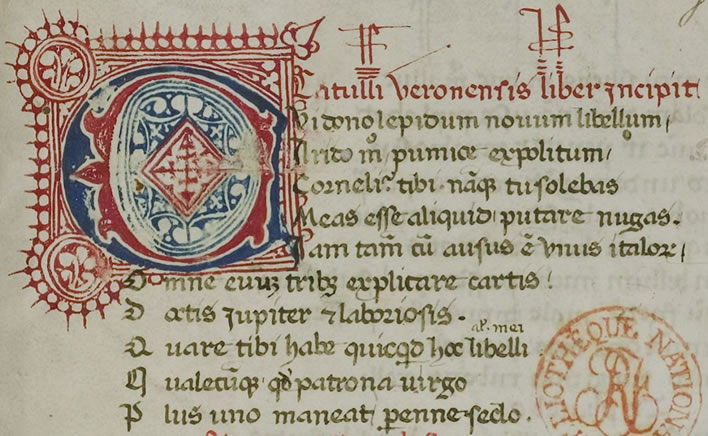
[c 1] Image: BnF, Manuscript G, 1r.
We note particularly that, in contrast with the luxurious production of Suffenus' roll, which he had mocked in [c 22], Catullus' work is notably modest.
To whom inscribe my charming new book—just out and with ashen pumice polished? Cornelius, to you! for you used to deem my triflings of account, and at a time when you alone of Italians dared unfold the ages' abstract in three chronicles—learned, by Jupiter!—and most laboriously written. Therefore take this booklet, such as it is, and, O Virgin Patroness, may it outlive generations more than one.
Cui dono lepidum novum libellum / arido modo pumice expolitum? / Corneli, tibi; namque tu solebas / meas esse aliquid putare nugas, / iam tum cum ausus es unus Italorum / omne aevum tribus explicare chartis, / doctis, Iuppiter, et laboriosis! / quare habe tibi quidquid hoc libelli / qualecumque, quod, o patrona virgo, / plus uno maneat perenne saeclo.
[c 1]
We are not told whether the papyrus was a second-hand palimpsest, such as that scorned by Suffenus for his noble product. Some commentators take the polishing with 'ashen pumice' to refer to a process commonly used to finish of the outer ends of the roll, a process that was also mentioned in the tirade against Suffenus. The mention of this final professional finish may reflect Catullus' pride at having a finished product in his hands – the same pleasure today's author has at the first sight of a published book fresh from the printer.
Thus it seems that at least some of Catullus' poetry was consigned to rolls during his lifetime. We can imagine that individual sheets of papyrus would also have been passed around his friends and fellow poets. Those who wished could make their own copies. Literature at the time was a pursuit for the independently wealthy – what such people wanted for their products was recognition, not money, so that once a piece or a collection was written it should take flight towards the widest audience possible.
0 Comments UTC Loaded:
Input rules for comments: No HTML, no images. Comments can be nested to a depth of eight. Surround a long quotation with curly braces: {blockquote}. Well-formed URLs will be rendered as links automatically. Do not click on links unless you are confident that they are safe. You have been warned!